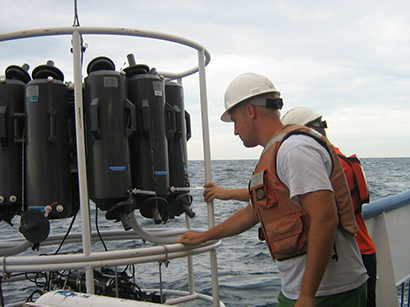
Matt Garrett of the Florida Fish and Wildlife Conservation Commission, who managed the ECOHAB project, handles a rosette of Niskin bottles, which are used to collect water samples from various depths.
First the good news: Red tide feeds on nutrients released from land, so management actions that reduce inshore pollution will likely diminish the duration and strength of the toxic blooms.
Then the bad news: The organism that causes red tides feeds on a multitude of sources, including many that cannot be controlled with current technology.
A five-year study published late last year looked at red tide blooms caused by Karenia brevis in 2001, 2007, 2008 and 2009 — as well as 2010 when there were no blooms. Dubbed ECOHAB — or Ecology and Oceanography of Harmful Algal Blooms — the $4.8 million study was funded through the National Oceanic and Atmospheric Administration and published as a special edition of the journal Harmful Algae.
Researchers from seven institutions studied the nutrients that support red tide, along with the microbiology, physiology, ecology and physical factors that impact its growth.
K. brevis is one of the more complex organisms studied in Florida waters, says Matt Garrett, marine research associate at the Florida Fish and Wildlife Research Institute who managed the ECOHAB project. “We didn’t find the smoking gun — or even two or three guns,” he said. “There are so many connected pieces that the more answers we got, the more questions we had.”
Ongoing research had already shown that blooms start 10 to 40 miles offshore where nutrient levels are very low. If conditions are right, red tide moves closer to shore.
A total of 12 nutrient sources, including six which had not been previously documented, were studied. Offshore, the most important source of nitrogen is the bacteria Trichodesmium, which captures atmospheric nitrogen and transforms it to a more usable form. Closer to shore, major food sources are land-based nutrients and nutrients released from underwater sediments.
The researchers concluded that many of these nutrient sources are individually more than enough to support observed blooms, but no single nutrient source is solely responsible.
“Nature is messy, but this project has put several new pieces in place,” said Kellie Dixon, senior scientist at Mote Marine Laboratory and co-principal investigator for the project. “Until now we had not looked at this many of the 12 sources and their specific quantities simultaneously. Some of the sources, like nutrients released from the sediments, had never been measured in southwest Florida’s coastal waters.”
[su_pullquote align=”right”]“Nature is messy, but this project has put several new pieces in place.”—Kellie Dixon, senior scientist at Mote[/su_pullquote]
That flexibility on food sources — as well as its ability to actively and purposefully move through water rather than just float in currents — also complicates any potential control of K. brevis.

Karenia brevis is a single-cell dinoflagellate which can create its own energy using photosynthesis or consume any of 12 food sources, including man-made nutrients as well as multiple naturally occurring substances. Native to the Gulf of Mexico, K. brevis blooms almost annually with the first fish kill documented in 1528. It produces toxins that can kill fish, birds and marine mammals. The toxins can become airborne and cause respiratory issues in people as far as three miles inland. Beach clean-ups, tourism losses and medical expenses average more than $1 million for each bloom event.
“One of the most interesting things that hadn’t previously been taken into account is this organism’s ability to not just use sunlight, like plants, but to also consume other single-celled organisms as a nutrient source,” adds co-editor Judith O’Neil, research associate professor at the University of Maryland Center for Environmental Science. “Additionally, its migratory behavior and directed swimming allows access to nutrient sources everywhere it finds them — at the surface, bottom and throughout the water column.”
Red tide blooms have occurred every year since the project ended in 2010, but they’ve stayed offshore where their ecological and economic impacts have not been as apparent, Garrett said. That may be the result of changing undersea currents in the Gulf of Mexico not driving the blooms to shore.
Those currents are now being tracked in a partnership with the University of South Florida which has created a tool to help monitor and manage red tide blooms (online at http://ocgweb.marine.usf.edu/hab_tracking/HAB_trajectories.html).
Ironically, the Deepwater Horizon oil spill pointed out how little is known about those currents, but provided impetus and additional funding to expand the effort.
Knowing that Trichodesmium is an important food source also allows scientists to concentrate field work in areas where high concentrations of those bacteria are found. “The goal here is to allow us to predict when and where red tide will come ashore,” Garrett said. “It affects so many industries, from tourism to fishing, that we want to offer seasonal predictions, like the hurricane season forecasts, so people can adjust or mitigate for the bloom.”
[su_divider]